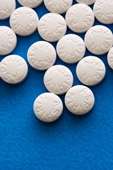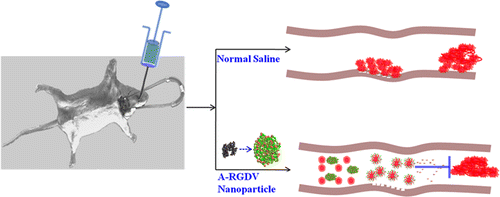A new form of 'nanosized' aspirin to overcome 'aspirin resistance'

Scientists are reporting development of a new form of aspirin—taken daily by about 60 million people in the United States alone to reduce the risk of heart attack and stroke—that could extend aspirin's benefits to people who may not respond to the drug. Their advance toward coping with "aspirin resistance" appears in the journal ACS Nano.
Shiqi Peng, Ming Zhao and colleagues note that aspirin lowers cardiovascular disease risk by keeping blood cells called platelets from clumping and forming clots. But some experts believe that aspirin doesn't work for millions of people, who may switch to more costly, potent prescription drugs with more serious side effects. Scientists have tried to address aspirin resistance by combining it with other drugs. But Peng and Zhao say that the problem remains. Their research group decided to modify aspirin in an effort to make it work for more people.
They linked aspirin to a carrier consisting of a fragment of protein that can transport aspirin directly to damaged parts of blood vessels where clots form. Experiments with laboratory rats, stand-ins for humans in such early tests, showed that the carrier delivered aspirin to areas of blood vessels where clots were forming. It released aspirin inside the developing clot and stopped the clot-formation process.

The article is titled "Nano-Sized Aspirin-Arg-Gly-Asp-Val: Delivery of Aspirin to Thrombus by the Target Carrier Arg-Gly-Asp-Val Tetrapeptide."
More information: Nanosized Aspirin-Arg-Gly-Asp-Val: Delivery of Aspirin to Thrombus by the Target Carrier Arg-Gly-Asp-Val Tetrapeptide, ACS Nano, Article ASAP. DOI: 10.1021/nn402171v
Abstract
Resistance and nonresponse to aspirin dramatically decreases its therapeutic efficacy. To overcome this issue, a small-molecule thrombus-targeting drug delivery system, aspirin-Arg-Gly-Asp-Val (A-RGDV), is developed by covalently linking Arg-Gly-Asp-Val tetrapeptide with aspirin. The 2D ROESY NMR and ESI-MS spectra support a molecular model of an A-RGDV tetramer. Transmission electron microscopy images suggest that the tetramer spontaneously assembles to nanoparticles (ranging from 5 to 50 nm in diameter) in water. Scanning electron microscopy images and atomic force microscopy images indicate that the smaller nanoparticles of A-RGDV further assemble to bigger particles that are stable in rat blood. The delivery investigation implies that in rat blood A-RGDV is able to keep its molecular integrity, while in a thrombus it releases aspirin. The in vitro antiplatelet aggregation assay suggests that A-RGDV selectively inhibits arachidonic acid induced platelet aggregation. The mechanisms of action probably include releasing aspirin, modifying cyclic oxidase, and decreasing the expression of GPIIb/IIIa. The in vivo assay demonstrates that the effective antithrombotic dose of A-RGDV is 16700-fold lower than the nonresponsive dose of aspirin.
Journal information: ACS Nano
Provided by American Chemical Society

















